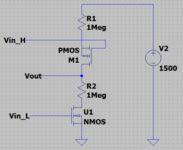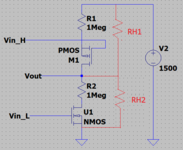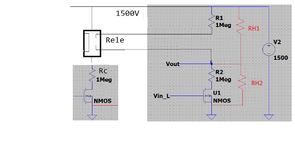roiberts
Junior Member level 1
Dear Forum
i have a voltage divider ,supplyed with 800V, formed by 2 resistor R1 R2 of 1Mohm each one (in realty
i connect more in serie for divide the power) ,so the current is some mA . Because I need to open and
close current flow,as switch I use a N-MOS in the lower side of partition (with Source to GND and Drain to R2 ) ,
or, in alternative, a PMOS or OptoMos ,in upper side of partition (with Source to Power and Drain to R1).
Now I need to work at 1500V,and here I have some problem in find the right MOS.
At this voltage, i find a NMOS (VCEO up to 1700V) but not a PMOS(VCEO max 800V) . So, no problem for interrupt the
low side of partition, but yes to interrupt the upper side.
So, first question is:
1)Why PMOS dont stand a VCEO as NMOS ? Also, non PNP for 1500V . No chance to interrupt the upper side of partition.
2)Another intresting fact is that all MOS i find are rated for hight current ( many ampere), while, in my circuit flow some mA,
Ths make MOS more expensive and bigger . No HV mos and low current ?
3)No optocoupler o opto mos to this voltage ,but I find IGBT support 1700V(10A !!!),and they have PNP supporting such VCE.
Is the IGBT the only solution for Hight side switch
Thanks for your help and time spend for me
Roberto
i have a voltage divider ,supplyed with 800V, formed by 2 resistor R1 R2 of 1Mohm each one (in realty
i connect more in serie for divide the power) ,so the current is some mA . Because I need to open and
close current flow,as switch I use a N-MOS in the lower side of partition (with Source to GND and Drain to R2 ) ,
or, in alternative, a PMOS or OptoMos ,in upper side of partition (with Source to Power and Drain to R1).
Now I need to work at 1500V,and here I have some problem in find the right MOS.
At this voltage, i find a NMOS (VCEO up to 1700V) but not a PMOS(VCEO max 800V) . So, no problem for interrupt the
low side of partition, but yes to interrupt the upper side.
So, first question is:
1)Why PMOS dont stand a VCEO as NMOS ? Also, non PNP for 1500V . No chance to interrupt the upper side of partition.
2)Another intresting fact is that all MOS i find are rated for hight current ( many ampere), while, in my circuit flow some mA,
Ths make MOS more expensive and bigger . No HV mos and low current ?
3)No optocoupler o opto mos to this voltage ,but I find IGBT support 1700V(10A !!!),and they have PNP supporting such VCE.
Is the IGBT the only solution for Hight side switch
Thanks for your help and time spend for me
Roberto


